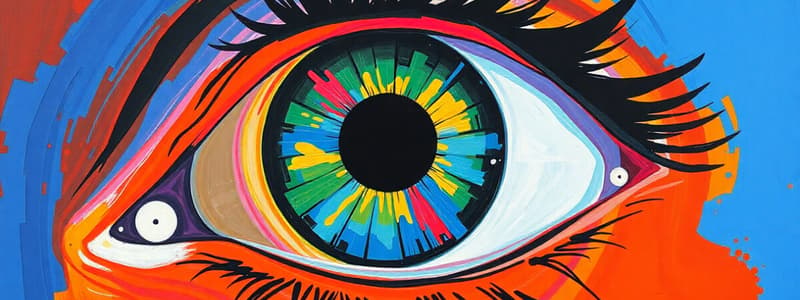Podcast
Questions and Answers
What is the condition where a person can see nearby objects clearly but struggles with distant objects?
What is the condition where a person can see nearby objects clearly but struggles with distant objects?
- Cataract
- Myopia (correct)
- Hypermetropia
- Presbyopia
The far point of a normal eye is considered to be at infinity.
The far point of a normal eye is considered to be at infinity.
True (A)
What type of lens is used to correct hypermetropia?
What type of lens is used to correct hypermetropia?
Convex lens
The least distance of distinct vision for a young adult with normal vision is approximately __ cm.
The least distance of distinct vision for a young adult with normal vision is approximately __ cm.
Match the following vision defects with their descriptions:
Match the following vision defects with their descriptions:
What causes the image of nearby objects to form behind the retina in hypermetropia?
What causes the image of nearby objects to form behind the retina in hypermetropia?
A bifocal lens consists of only concave lenses.
A bifocal lens consists of only concave lenses.
What happens to the power of accommodation as individuals age?
What happens to the power of accommodation as individuals age?
What is the primary medical condition characterized by a progressive clouding of the eye lens?
What is the primary medical condition characterized by a progressive clouding of the eye lens?
Hypermetropia is the defect where a person cannot see objects farther than a specific distance.
Hypermetropia is the defect where a person cannot see objects farther than a specific distance.
What type of lens is used to correct myopia?
What type of lens is used to correct myopia?
The phenomenon of splitting of white light into seven constituent colors is known as __________.
The phenomenon of splitting of white light into seven constituent colors is known as __________.
If a person cannot see objects closer than 75 cm, what is the nature of their vision?
If a person cannot see objects closer than 75 cm, what is the nature of their vision?
Match the optical defect with its description:
Match the optical defect with its description:
The correcting lens for hypermetropia is a concave lens.
The correcting lens for hypermetropia is a concave lens.
What is the angle between the incident ray and the emergent ray when light passes through a prism called?
What is the angle between the incident ray and the emergent ray when light passes through a prism called?
Which condition is characterized by difficulty in seeing distant objects clearly?
Which condition is characterized by difficulty in seeing distant objects clearly?
A cataract causes clouding of the lens of the eye, affecting vision.
A cataract causes clouding of the lens of the eye, affecting vision.
What is the term for the age-related condition that affects near vision?
What is the term for the age-related condition that affects near vision?
In __________, distant objects appear blurry while nearby objects can be seen clearly.
In __________, distant objects appear blurry while nearby objects can be seen clearly.
Match the eye conditions with their descriptions:
Match the eye conditions with their descriptions:
Which optical correction is typically used for myopia?
Which optical correction is typically used for myopia?
Hypermetropia allows individuals to see both near and far objects clearly without optical correction.
Hypermetropia allows individuals to see both near and far objects clearly without optical correction.
What type of lens is used to correct presbyopia?
What type of lens is used to correct presbyopia?
Flashcards are hidden until you start studying
Study Notes
Hypermetropia
- A person can see nearby objects clearly but struggles with distant objects.
- The far point of a normal eye is at infinity.
- A convex lens is used to correct hypermetropia.
- The least distance of distinct vision for a young adult with normal vision is approximately 25 cm.
- Hypermetropia is caused by the image of nearby objects forming behind the retina.
- The power of accommodation decreases as individuals age.
- Hypermetropia is the defect where a person cannot see objects farther than a specific distance.
Myopia
- A concave lens is used to correct myopia.
- Myopia is characterized by difficulty in seeing distant objects clearly.
Presbyopia
- Presbyopia is the age-related condition that affects near vision.
- A convex lens is used to correct presbyopia.
Cataract
- A cataract causes clouding of the lens of the eye, affecting vision.
Other terms
- The phenomenon of splitting of white light into seven constituent colors is known as dispersion.
- If a person cannot see objects closer than 75 cm, they have hypermetropia.
- The angle between the incident ray and the emergent ray when light passes through a prism is called the angle of deviation.
- Myopia is the condition where distant objects appear blurry while nearby objects can be seen clearly.
Vision Conditions and Descriptions
- Myopia is the condition where a person cannot see distant objects clearly.
- Hypermetropia is the condition where a person cannot see near objects clearly.
- Presbyopia is the condition where a person has difficulty focusing on near objects due to a loss of elasticity in the eye lens.
- Cataract is a clouding of the natural lens of the eye, causing blurry and distorted vision.
Studying That Suits You
Use AI to generate personalized quizzes and flashcards to suit your learning preferences.




